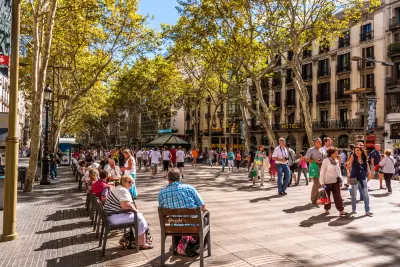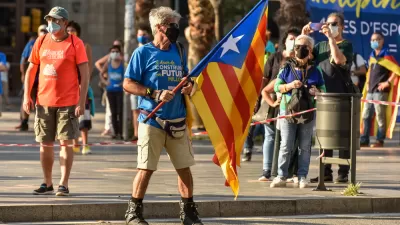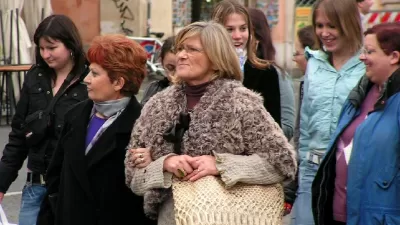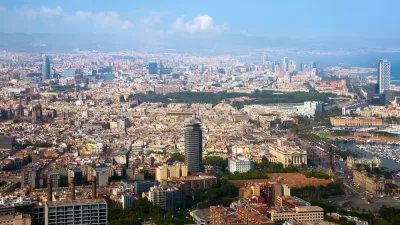Seeking relief from noise, pollution, and incessant traffic, the city of Barcelona has a bold plan to repurpose street space. "Superblocks" will route cars around the perimeter, leaving interior streets open for walkers and bikes.

Like many American cities, Barcelona devotes most of its road space to cars: "Private vehicles account for just 20% of total movements in the city today and yet they occupy 60% of roads." In pursuit of a 21% reduction in traffic, Barcelona's new mobility plan places heavy emphasis on the concept of superilles, or "superblocks." Marta Bausells discusses the ambitious plan in detail.
"In Eixample, a superblock will consist of nine existing blocks of the grid. Car, scooter, lorry and bus traffic will then be restricted to just the roads in the superblock perimeters, and they will only be allowed in the streets in between if they are residents or providing local businesses, and at a greatly reduced speed of 10km/h (typically the speed limit across the city is 50km/h, and 30km/h in specific areas)."
The city will roll out the superblock concept in series of gradual interventions, changing road signs and bus routes while leaving much of the streetscape intact. The superblocks idea has been around since 1987, and the first tests began in Barcelona in 2003. Currently, the idea is already being tested in nine districts via a trial-and-error process that has been called tactical urbanism.
The city hopes to achieve its 21% traffic reduction in two years, along with a corresponding shift to bikes, buses, and pedestrian trips. To get there, 300 km of new bike lanes are in the works.
FULL STORY: Superblocks to the rescue: Barcelona’s plan to give streets back to residents

Maui's Vacation Rental Debate Turns Ugly
Verbal attacks, misinformation campaigns and fistfights plague a high-stakes debate to convert thousands of vacation rentals into long-term housing.

Planetizen Federal Action Tracker
A weekly monitor of how Trump’s orders and actions are impacting planners and planning in America.

In Urban Planning, AI Prompting Could be the New Design Thinking
Creativity has long been key to great urban design. What if we see AI as our new creative partner?

How Trump's HUD Budget Proposal Would Harm Homelessness Response
Experts say the change to the HUD budget would make it more difficult to identify people who are homeless and connect them with services, and to prevent homelessness.

The Vast Potential of the Right-of-Way
One writer argues that the space between two building faces is the most important element of the built environment.

Florida Seniors Face Rising Homelessness Risk
High housing costs are pushing more seniors, many of them on a fixed income, into homelessness.
Urban Design for Planners 1: Software Tools
This six-course series explores essential urban design concepts using open source software and equips planners with the tools they need to participate fully in the urban design process.
Planning for Universal Design
Learn the tools for implementing Universal Design in planning regulations.
Gallatin County Department of Planning & Community Development
Heyer Gruel & Associates PA
JM Goldson LLC
Mpact (founded as Rail~Volution)
City of Camden Redevelopment Agency
City of Astoria
Jefferson Parish Government
Camden Redevelopment Agency
City of Claremont





























